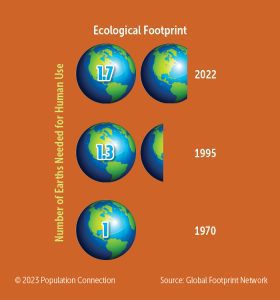Tomorrow is an alarming reminder that we’re burning through the planet’s resources faster than it can recover. Earth Overshoot Day 2025 falls on July 24. It’s the day when our demand on nature exceeds what the planet can renew for this year.
Thanks to the Global Footprint Network, which has been tracking this for years, we have a clear picture of our collective ecological footprint and its impact on the planet’s resources. The bad news? As a whole, we’re consuming far more resources than the Earth can renew them. In fact, society is demanding the resources and services from nature at a rate nearly twice what the Earth can supply. This means we are currently using the equivalent of 1.8 Earths to support us. We simply can’t keep up this pace of ecological overshoot without disastrous consequences.

Let’s rewind the clock. Fifty years ago, in 1975, Overshoot Day was November 29. Twenty-five years ago, it was September 23. At our current pace of over-consumption, the date will fall in June by 2030. It should come as no surprise that during this same timeframe, global population has already doubled. The movement of Earth Overshoot Day is a wake-up call that our current habits are pushing the planet beyond what it can handle.
What Causes Ecological Overshoot: Resources In, Resources Out
Let’s break it down. Every country has a biocapacity – its capacity to produce renewable resources, such as trees or fish, and to absorb wastes, such as carbon dioxide. We create an ecological footprint by using those natural resources and producing waste. All of our actions, from driving and heating our homes to the food we put on our plates, add up to our footprint. Ecological overshoot happens when our footprint exceeds our biocapacity – we overshoot the planet’s ability to regenerate its natural resources.
Think of Earth’s resources like a pantry stocked with enough food for an entire year. Every tree that grows, fish that we catch, and the clean air that nature provides is part of that supply. By Overshoot Day, we’ve already emptied the shelves, and our next delivery isn’t coming anytime soon.
The unsustainable rates of deforestation, fishing, agriculture, and energy production all add to our shared ecological deficit. These impacts are getting larger and more severe, with 8 billion people on the planet (and still growing).
Proof That Change Is Possible
In 2020, we witnessed a marked shift: for the first time in decades, Earth Overshoot Day occurred three weeks later than in the prior year. It was, in many ways, a respite for the Earth. Due to COVID-19, travel was curtailed, industries shut down, and, in many places, people had to stay indoors. We saw a reduction in global carbon emissions and overall resource use, resulting in a 9.3 percent decrease in the global ecological footprint. Our ecological overshoot did not move earlier until July 29, 2021, when Overshoot Day “rebounded” when the world “re-opened.” Though small, it was proof that if human activity changes, so does the fate of the Earth. That we can #movethedate is no longer a question.
How to Move the Date: Ways to Reduce Your Ecological Footprint and Push Back Overshoot Day
Here’s the hopeful part: a sustainable future is within reach. Earth overshoot day challenges us to take note of, and reduce, our ecological footprint. We can all work together to #MoveTheDate – pushing the day we exceed Earth’s limits later in the year.
Achieving this calls for systemic change in how we produce, consume, and manage the Earth’s resources through collective action. A large part of this must come from governments and industries. Big changes require big players.
 That being said, personal actions can be easier to grasp for younger students. Take public transportation, purchase recycled paper products, and cut down on single-use plastic. Take the Footprint quiz to find out how your lifestyle choices impact the planet and where you can make a difference. Buy local, eat fewer processed foods, opt for sustainably harvested seafood, or try going meatless some days to help lower the energy and resources needed to feed us. Check out these sustainable living tips to make your summer more eco-friendly!
That being said, personal actions can be easier to grasp for younger students. Take public transportation, purchase recycled paper products, and cut down on single-use plastic. Take the Footprint quiz to find out how your lifestyle choices impact the planet and where you can make a difference. Buy local, eat fewer processed foods, opt for sustainably harvested seafood, or try going meatless some days to help lower the energy and resources needed to feed us. Check out these sustainable living tips to make your summer more eco-friendly!
The PopEd lesson Lend a Hand to the Earth is a wonderful option to help young learners explore the power of both collective and individual action to help the planet, and possibly move Earth Overshoot Day! For older students, the lesson Needs vs. Wants in a Finite World helps teens consider the resources used to make their needs and wants, and consider them when making daily decisions.
Earth Overshoot Day Success Stories
Explore the Global Footprint Network’s Power of Possibility, a platform that showcases real-world solutions focused on five critical areas (healthy planet, cities, energy, food, and population). See how many days we can #MoveTheDate by embracing these kinds of solutions.


